Australian Capital Territory
National Archives of Australia
Staff Changes
Donna Wilks is with us from the National Museum of Australia until the end of the financial year. Her preventive conservation background has come in extremely handy. Stephen Willet returns to us after a year at the National Museum. It’s great to have him back. Unfortunately, we had to say goodbye to Melanie Wundke on Steve’s return as she was acting in his position, but she has been able to continue with the NAA in our WWII digitisation project. We were also sad to say goodbye to Kylie Roth who left us to join the team at Parliament House.
Events
COVID-19 still sees us working but we have been split into two with the teams alternating between working from home one week and at work the next. This has obviously limited treatment work and means we haven’t seen some of our friends and colleagues for what seems a very long time. It does mean that we have had a good chance to get up to date with online training and research and updating those procedures and documents that we often don’t get around to doing.
Our old repository on the corner of Sandford St and Flemington Rd in Mitchell has been completely refurbished and we have moved records back into the space. Other institutions are also renting space within the building.
We had an electrical fire in a dehumidifier in one of our plant rooms in the NAPF, our main storage facility, in May. As with most such incidents, it started around 4 o’clock in the morning. The alarm systems and disaster response worked successfully and the fire was put out quickly. Sally Kneebone, Suellen Bailey and Donna Wilks from Preservation were called in to give advice. Some smoke did make it into the cold store repositories but it appears that the activated-carbon filters did their job. Smoke also entered the preservation lab. At the time of writing we are waiting on the results of the swab tests that were taken but the VOCs in the air were back to safe and negligible levels on the day.
Exhibitions
Late last year and earlier this year, the exhibition spaces in our Parkes building were handed back to the Archives after refurbishment and renovations to the building. The first space back was our temporary gallery and we opened our Travelling exhibition Spy: Espionage in Australia in October. Our permanent gallery, the Connections gallery, was installed and opened to the public in December and our permanent gallery, the Voices gallery, was installed in February. All the lab staff chipped in and we got through this very busy schedule. Unfortunately, due to COVID-19, the gallery spaces are closed at the moment, as is our reading room. Spy has been de-installed and was to be installed at the Museum of the Great Southern in Albany but this had to be cancelled due to COVID-19. Hopefully, our travelling exhibition schedule will be back up and running in the not too distant future. We are also working on our Out of this World exhibition, which will be opening at NAA first and then travelling around Australia. We have bought and are now using new Wi-fi data loggers within the gallery spaces. It is definitely handier to be able to see the data online while leaving the loggers in situ.
National Gallery of Australia
In March, the gallery closed its doors to the public due to the COVID-19 pandemic. While the gallery has been closed, the Conservation Department has remained working onsite. As the usually very busy exhibition schedule has slowed, the department has had the opportunity to undertake some larger treatment and research projects. It has been a productive but challenging time with adjustments to processes and workspaces to maintain social distancing rules.
Objects Conservation has been busy working through exhibitions lists in preparation for the eventual reopening of the gallery. Alysha is currently undertaking treatment on several Lucas Samaras sculptures. Jack has been cleaning and maintaining works in the Sculpture Garden and undertaking analysis into the composition of metals used in the work. Kim is condition reporting works of art for changeover in the Melanesian galleries.
Andrea, James, and Fiona in the Paper Conservation section have been busy undertaking major treatments on several Asian scroll paintings. During these treatments they have also been conducting analysis of scroll pigments using a polarised light microscope on minute dispersed and mounted samples. Scott, Masa, and Surya in mount counting have been busy mounting future loans and works identified for upcoming changeovers and exhibitions. They have also been cleaning and repairing frames and checking stocks.
In Paintings Conservation, while the gallery has been closed to the public, David has been undertaking analysis of Blue Poles by Jackson Pollock. Jocelyn has recently completed treatment of a Frank Stella work and has started treating a Stannage painting for the Know My Name exhibition. Kensuke has been busy restretching a large group of paintings from the Aboriginal and Torres Strait Islander collection.
The Textile Conservation section has prepared many fashion items including some new acquisitions for imaging, including some heavily embellished costumes by Sydney-based contemporary fashion house Romance Was Born. Carmela has been working on completing a major treatment of an Indian patola and finalising analysis and treatment of corroded lead weighting in an Yves Saint Laurent dress from 1960. Michelle has recently completed a long-term treatment of an 18th century kalamkari, which involved supporting many areas of loss. Once a heading cloth has been attached to the nearly five-metre length, it will be ready for display after many years of treatment.
Lisa, Rose and Cheree have been active with pest management, advising the capital works projects and trying to manage the ever-changing loans program.
National Library of Australia
The NLA book and paper lab has seen quite a few changes in the last few months! Like everywhere else, we have instituted a variety of new and flexible working arrangements to deal with the outbreak of COVID-19.
During March, Senior Conservator Freya Merrell took advantage of the Library being closed to the public to lead the team on a mission to condition check, clean and report on our permanent display objects and public art.
Freya and book and paper conservator Adele Barbara also worked through March to install our new major exhibition—Australian Dreams—focusing on Australian architecture. It will be lovely to have a fresh exhibition to reopen with!
With restrictions tightening leading up to April, Camielle Fitzmaurice and Adele returned home to Melbourne to work from home. Other lab members Sara Freeman, Jenni Todd, Janet McDonald, Lab Manager Lisa Jeong-Reuss, and our Director Tania Rivere have taken to flexible working schedules, which see them in the lab part-time.
As a team, we are using the WFH situation to undertake several significant research projects and updates to our procedural guidelines. Jenni is working on updating guidelines for exhibition furniture and display cases, investigating contemporary approaches to off-gassing parameters for exhibition materials and low-VOC paints. Camielle and Adele are enjoying working together from their homes on several projects using screen-share and chat apps. Their main challenge is to assess and refresh Care and Handling guidelines for NLA staff and contractors. It has been an interesting adjustment for most of us to spend more time in front of a computer screen!
When they are in the lab, Jenni and Sara are also working on condition reporting and prepping for our upcoming Ellis Rowan exhibition (to enjoy in a post-COVID world). The NLA has taken the opportunity to feature our book and paper lab in an interview with NLA curators, which can be viewed here.
During the last two weeks we completed our first ‘virtual’ book training workshop. Camielle is leading the team in what will be a four-session effort to make a model of Kathy Abott’s ‘sacred binding’. This method was taught at her workshop on ‘Conservation Binding’ in November last year.
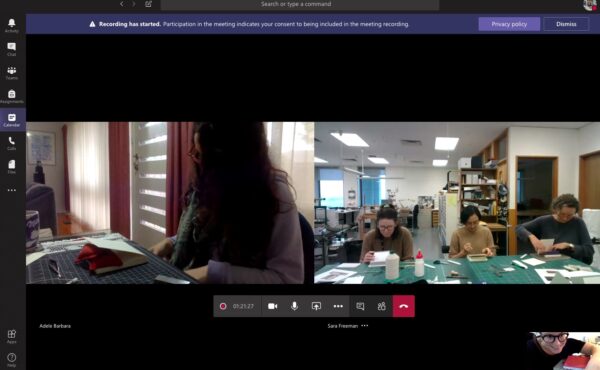
Image: Screen shot of sacred binding teams tech meeting, Session 1.
Our Digitisation program continues strongly, with Digitisation Conservator Janet McDonald continuing to survey material and work on stabilising Monash letter books and our pre-1989 poster collection.
Meanwhile, Lisa is busy working and crunching numbers on our Bidding and Estimation program for our 2020–21 workflow.
Tania Rivere (from the National Museum of Australia) remains as current Acting Director of Collection Care and has been an amazing support to all of us during these ever-changing times! Between bushfires, hailstorms and COVID-19 she has been working hard to keep us informed and on-track.
Lastly, and most importantly, we have seen two Preservation Services team members off on secondment to Services Australia. Freya Merrell and Assistant Director of Preservation Denyl Cloughly (along with Gareth Kay from Digital Preservation) have volunteered to work full time at Services Australia processing Jobseeker payments for those who have suffered the most financially from the outbreak of COVID-19. They are working with a team of 2000 seconded people from government agencies across the ACT – the newly created APS2000! Last week they processed half of the remaining claims, which are making serious impacts for Australians who are doing it tough. Working in teams of around 30, the APS2000 are using computer-generated information, correcting any errors to ensure the eligibility of individuals and making sure they are being paid from the right date. Freya, Denyl and Gareth have undergone extensive training in these programs and have been thrown into a new work environment overnight. We couldn’t be prouder of their efforts!
New South Wales
Art Gallery NSW
What a couple of months it has been for the AGNSW Conservation Department, as indeed it has been for the conservation community as a whole. Who could have predicted the halting of ‘day-to-day’ life and closure of cultural institutions and businesses worldwide? The virtual has taken over the tangible with Zoom meetings, online learning and remote access to institutional operating systems.
In true conservation spirit, the AGNSW team has utilised this unique period of Gallery closure to its advantage. We have found that working from home with alternating days in the gallery has been a great opportunity for us to do things that we would normally struggle to find the time for, such as research, writing, working on the archive, consolidating documentation, catching up on data entry and taking the time to write up interesting projects. The team has harnessed this opportunity to consolidate thoughts and ideas and reflect on our ever-changing profession.
Paper Conservation
Before closure, the Paper Team had just welcomed Lois Waters who commenced working at the Gallery in late Feb. On arrival, Lois was thrown straight into the preparation of archival material for the Margel Hinder: modern in motion exhibition, the treatment of new acquisitions and works required for changeovers at Brett Whiteley Studios and in the Prints and Drawings study room. Lois is currently working from home three days a week on data entry, condition reports for the Margel Hinder and Classicism exhibitions, and research into screenprints in the AGNSW collection. She is continuing treatments on the Hinder works one day per week onsite, focusing on a series of fragile spiral-bound sketchbooks.
Lois and Sarah Bunn recently took part in the Modular Cleaning Program offered online by staff from the University of Delaware and will be participating in an interest group formed in response to this workshop specifically for paper conservators. Sarah Bunn has been working from home three days a week on data entry, exhibition lists and a joint poster on Yang Zhichao’s Chinese bible for the upcoming ICOM-CC conference in Beijing in 2021.
Analiese Treacy has been part of a skeleton conservation team working onsite one day per week, spot checking the condition of items still on display and installing works for the upcoming exhibition Some mysterious process: 50 years of collecting international art, which delves into significant acquisitions made by the Gallery over the last 50 years. Analiese has also been adapting to the constant changes being brought with the outward loan program and ensuring that the Gallery can facilitate and support our regional institutions as they re-arrange their exhibition schedules.
Jonathan Dennis who has recently returned to the paper team, has been moonlighting with the Time-based Art Team, using his newly developed ‘investigative skills’ during his time in curatorial. He has been conducting in-depth research into contemporary artworks in the AGNSW collection that have complex iteration histories, in order to comprehensively document the past and potential future legacy of each artwork. Such Iteration History Reports become useful working documents across the broader collections department, as not only curators, but conservators, exhibitions designers, installers, and registrars are able to holistically view detailed and technical aspects, as well as similarities and differences across various displays of the artwork. Jonathan also commits this time to an ongoing backlog of data entry for the paper / mount cutting department, as well as research and writing a poster on float mounting contemporary works on paper for a future publication.
Paintings Conservation
In Paintings Conservation, Simon Ives and Paula Dredge have been working on their research projects for publications as well as undertaking treatments on paintings by Arthur Streeton in the lab on alternating days in order to maintain social distancing. Simon has begun removing a varnish on The Gloucester Buckets, an early NSW landscape painting from 1894, and Paula is retouching extensive drying cracks on Still glides the stream, and shall for ever glide 1890 and removing a non-original varnish on Beneath the peaks, Grampians 1920.
Melissa Harvey has been consolidating and updating our suppliers list as well as researching materials to create a new hanging system for the old courts that will help protect the frames in our collection. Mel has also been undertaking a TAFE online course in team leadership, assisting with the dusting of works on display, organising the recalibration of our environmental dataloggers and sorting and filing a number of different documents.
Ellie Gifford has just started a short-term contract with us in March and has been set up to work from home on the Sidney Nolan artist’s materials archive in Vernon. Working from home has allowed us to turn our attention to less urgent, more meticulous data-entry type work, so it has been a great opportunity to get some of this archiving work done. Ellie is also helping with monitoring and updating our outgoing loans requests.
Time-based Art Conservation
Asti Sherring has been using isolation to undertake digital preservation tasks for artworks from within the Gallery’s TBA Collection and the National Art Archive, while simultaneously supporting the Gallery’s increased digital access needs. Asti is especially enjoying working creatively on Together In Art projects, many of which will appear on the Gallery’s digital platforms over the coming months.
Rebecca Barnott-Clement has been using WFH time to develop new workflows and procedures to support the transition of the TBA Conservation team from the physical to digital realm. Bec has been enjoying the opportunity to dedicate herself to collection care tasks in an uninterrupted manner, and the chance to work collaboratively with other departments across the Gallery to review the ongoing needs of the TBA collection.
Jake Van Dugteren continues to work on the TBA Obsolete Equipment Project one day a week, using the time working from home to develop workflows and procedures for when the physical survey and assessment of obsolete equipment can be resumed. On his days working as part of the Install Team, Jake has been spending time at the Gallery solo-installing works in the upcoming exhibition Some mysterious process, which is set to open later in the year.
In the weeks leading up to the shutdown, TBA conservation welcomed Lisa Mansfield on a short-term contract. Lisa worked with TBA, Objects and Audio-visual teams to test, document and install Shaun Conrad’s complex TBA installation work Pre-retrospective for the collection exhibition Under the stars. See an online tour of the show here
Frames Conservation
In the rise of the COVID-19 pandemic in March, one day before due to travel, Malgorzata Sawicki cancelled her course on Cleaning Gilded Wooden Surfaces at the University of Gothenburg, Sweden. Both the University of Gothenburg and Malgorzata agreed that the course will be postponed until global travels resume, probably next year.
With closure of the Gallery, working from home arrangements have presented a great opportunity for the Frames Conservation Team to undertake research on frame labels and makers, advance datalogging on Vernon and tidy up the filing system. With many exhibitions in cultural institutions being postponed, Basia Dabrowa’s full conservation treatment of the Frank Mahony Rounding up a straggler frame and other frame treatments are on hold and she is working on documents and doing research from home.
On-site preparation for the 2020 retrospective exhibition Streeton has, however, been able to continue while observing social distancing protocols in the lab. Genevieve Tobin continues the major treatment of the frame for the Streeton painting The Gloucester Buckets, which is at an infilling and surface preparation stage for in-gilding and retouching. Tom Langlands has set up a home studio to work on the reproduction frames for Streeton, and has just finished two beautiful stained timber frames with gilded slips for A bush idyll and From my camp (Sirius Cove). Grace Barrand continues to work on the frame for Streeton’s The melon painting, a beautiful carved frame with a nod to neoclassicism, and has been using more time at home to work her way through the cookbook Ottolenghi SIMPLE by Yotam Ottolenghi (thanks for the tip, Tegan Anthes!).
Grace and Malgorzata both braved the 12:30am alarm to undertake Chris Stavroudis’ Modular Cleaning Program at the beginning of May. It was a fantastic and incredibly generous four-day workshop introducing the concepts and latest software of the program with over 400 conservators from around the world in attendance. Thank you, Chris!
Objects Conservation
Kerry Head, Sofia Lo Bianco and William Sit have been installing Some mysterious process at the Gallery, ensuring that works are ready in preparation for the reopening, and providing opportunities for works to be displayed online. WFH time has been spent updating data and researching artworks that will be displayed in Sydney Modern.
Melanie Barrett has been working on Margel Hinder works at the Gallery and WFH doing administration for a plastics survey of the artworks in the AGNSW collection.
Frances Cummings has been working hard keeping up with cancelled, postponed and rescheduled loans and exhibitions, while also doing artwork checks in the gallery and working on loans for the Margel Hinder exhibition.
Head of Conservation
Carolyn Murphy is working hard to keep conservation connected and informed in this fast-changing, new environment. Carolyn has been working closely with Anna Henry, Digitisation Project Manager, Asti Sherring and the Digital Preservation Project team to develop the systems, workflows and infrastructure required to support the digitisation and digital Preservation activities for the Gallery’s collections and cultural assets.
Our weekly Zoom meetings have also been helpful for keeping us all connected and checking in with how everyone is managing.

AGNSW Conservation team meeting via Zoom while working from home – all eyes on paintings conservator Simon Ives!
AGNSW conservation Joke Book
Now, for some light entertainment. Last year a handful of AGNSW conservators ditched the lunchtime crossword in favour of a more creative activity. The result was the Conservation Joke Book, which we would like to share with you all in this newsletter!
‘Are you sick of humourless meetings? Maybe you’re looking for a fantastic opener to that next conference presentation? Look no further! Tried and tested amongst leading industry professionals, the Conservation Joke Book is made by conservators, for conservators. Best enjoyed after quite a few glasses of wine. Like, a lot of wine. Proudly endorsed by the AICCM’
*This product is not endorsed by the AICCM.
Conservation Joke Book (with edits) [PDF – 2.6 MB]
Australian Museum
Collection Care and Conservation
Heather Bleechmore, Acting Manager – The current COVID-19 work arrangements have given us the opportunity to look at workflow and strategy documents for the Unit and focus on the future direction and growth of the lab. We are also writing updated digital content for the CC&C webpage to include staff profiles, current research and ongoing projects. Planning continues for the return to our new reconfigured lab post-Project Discover and bringing the Pest Management rooms online as soon as possible.
Most of the CC&C team are still on-site for all or part of the working week. IPM, environmental monitoring, gallery maintenance and scheduled works, exhibition preparation, storage-upgrade projects, materials testing, and Project Discover impacts remain essential programs for the team to run at the main William Street site. At the off-site stores, continuing collection assessments and new acquisition documentation for the Pacific collection are being carried out. At Castle Hill, the recent loan return of 700 Egyptian objects is being documented, and outstanding stillage fit outs and triage treatments are being completed for mounted taxidermy specimens.
Irene Finkelde and Melissa Holt joined the team in March to work on an 18-month-long project to rehouse our dry Type collections. Irene has come on board as Project Conservator and Melissa as Assistant Conservator.
Treatment Projects
Collection Enhancement Project (CEP)
Unexpected discoveries in Palaeontology Store
Clare Kim continues to work on condition assessments as part of CEP. Recently Clare noticed minor yellow webbings on several specimens in the Palaeontology collection. Examining with a microscope, clear evidence of pest activity was found, such as black frass, caterpillar head capsules, and shrivelled carcasses. These activities are consistent with pantry moths or perhaps clothes moths (order Lepidoptera). Further scientific analysis is planned to investigate what attracted moths in the Palaeontology store. FTIR analysis will be performed on old adhesives used on labels to test whether they are animal-based or cellulose-based products.
Dry Types Project
Extra funding has allowed a large-scale review of our Life and Geoscience dry Type collection items. Sheldon Teare put this project together and is coordinating it with Irene and Melissa. Type specimens act as the ‘name bearer’ for that species. All other specimens are compared with the type specimen to determine whether they belong to that species or are a new species. These are the most important specimens in the Life and Geosciences collections. The project will enable each specimen to be assessed, condition reported and photographed; and then rehoused into conservation-grade materials.
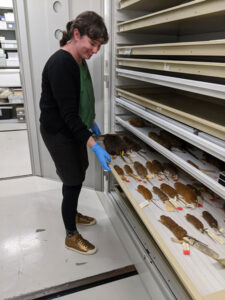
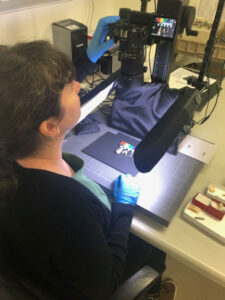
Images: Irene Finkelde assessing collection store and photographing a specimen.
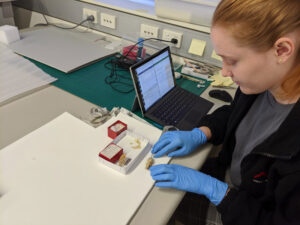
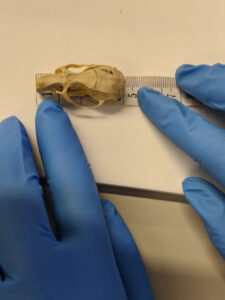
Images: Melissa Holt measuring specimens.

Image: Rehousing specimens.
Megan Dean-Jones and Sheldon Teare removed several specimens from our Wild Planet gallery to make way for ceiling repair work to take place. A range of historic taxidermy specimens was removed, rehoused, and stored awaiting return when the work is completed.
Sheldon and Rehan Scharenguivel removed a showcase of bird mounts and a bower from a gallery after finding a specimen with pest activity. These specimens were frozen and inspected for further pest damage. Sheldon carried out XRF testing on all specimens.
The Spiders exhibition was returned early from Queensland Museum, and Sheldon has begun processing the registered specimens before returning them to collections.
Conference Attendance
Sheldon and Rehan were in the middle of planning to travel to Edinburgh to attend the joint Society for the Preservation of Natural History Collections (SPNHC) and ICOM Natural History conference when the travel bans came into effect. The conference will be moving to an online version.
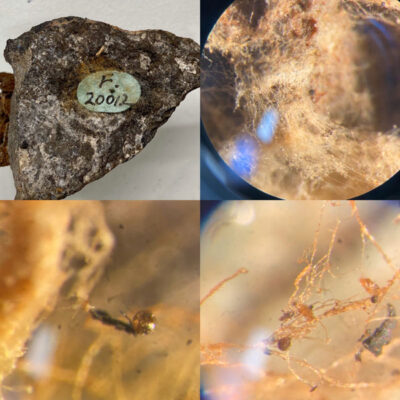
Image: Evidence of moth activity Specimen F.20012 (clockwise from top left): Overall image; Detail of yellow webbing with frass; Desiccated bodies; Caterpillar head capsule.
Australian National Maritime Museum
Treatment
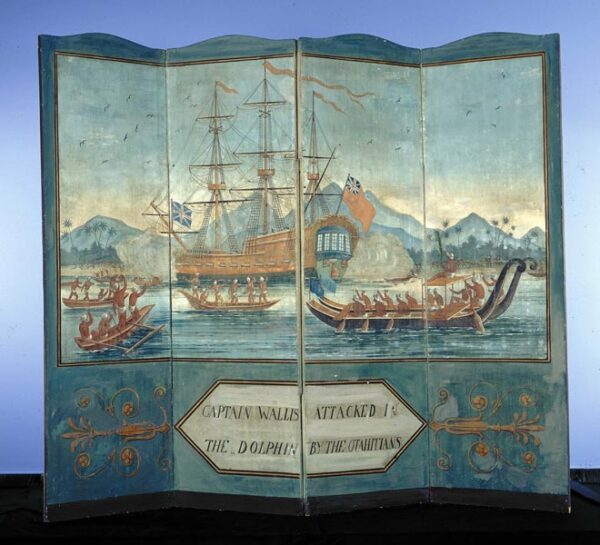
Image: Painted screen depicting Captain Samuel Wallis and HMS Dolphin attacked by Otahitians. Image: ANMM.
In April, Kim Vernon from David Stein & Co. spent a week in our lab consolidating the surface of a 19th century painted screen. The screen depicts Captain Samuel Wallis and Royal Naval frigate HMS Dolphin being attacked by Otahitians during his 1766–68 circumnavigation of the world. It will be on display in the new Under Southern Skies gallery when the museum reopens to the public.

Image: Ship’s medicine chest used by a Liverpool captain. Image: ANMM.
Nick Flood has been assessing the hazards of the medical kits in the National Maritime Collection. Nick’s top two are:
- Dr J Collis Browne’s chlorodyne – a treatment for cholera containing laudanum, tincture of cannabis and chloroform
- AM Bickford & Sons perchloride of mercury – mercuric chloride (Schedule 7 – Hazardous Poison), made by the manufacturers of your favourite Bickford’s Lime Cordial.
Exhibition Preparation
Jeff Fox has been busy for the last few weeks installing objects in the Under Southern Skies gallery.
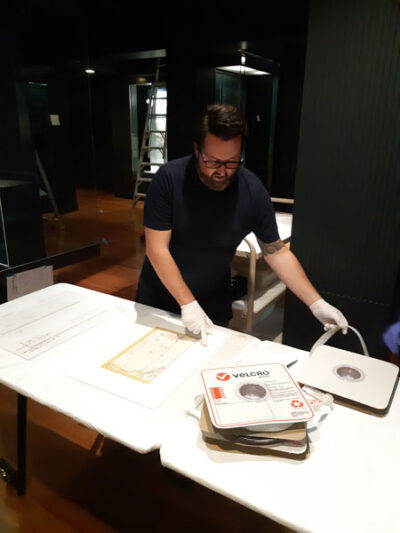
Image: Jeff Fox installing objects for the Under Southern Skies gallery. Image: ANMM.
Workshops Symposia and Media
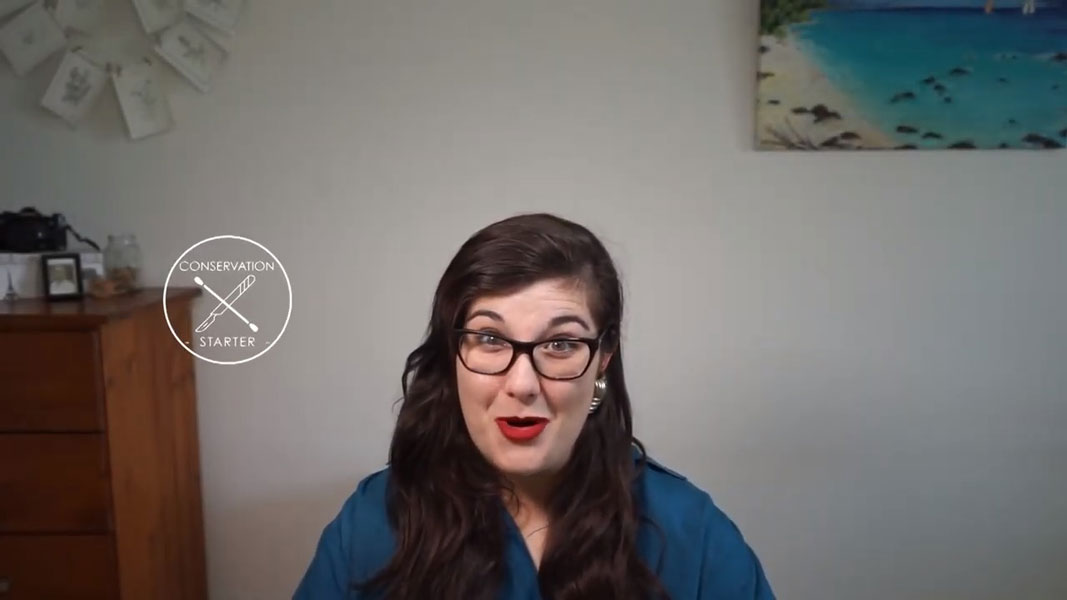
Image: Lucilla Ronai’s Letter Conservation for Exhibition video. Image: Lucilla Ronai.
Lucilla Ronai has been tirelessly filming her Museum from Home video series. At last count there were seven short videos available on her YouTube channel The Conservation Starter. Show your support and subscribe now.
Heights Heritage Conservation
Treatment Projects and Exhibitions
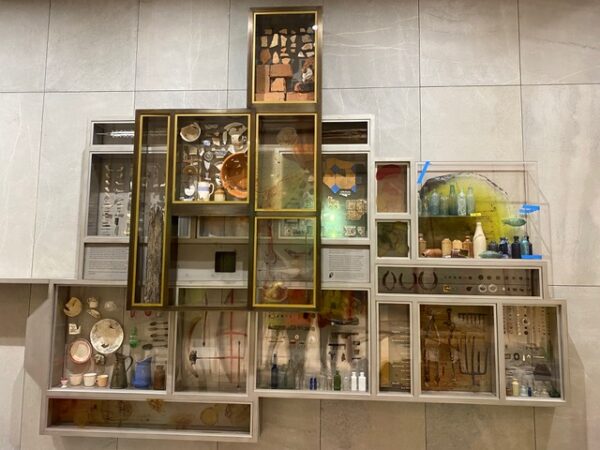
Image: 3 Paramatta Square Archaeological display. Image: Tess Evans

Image: Luna Park slippery-dip mat. Image: Tess Evans
One of the benefits of working alone is that social distancing requirements are automatically met within the workplace so, although quieter than usual, work hasn’t changed dramatically …
At the end of March, just before lockdown, Tess Evans completed the four exhibitions she had been preparing. All quite different, they required a variety of skills from cleaning and stabilising corroded horseshoes and ‘stitching’ and mounting archaeological artefacts to acrylic backboards to re-attaching hundreds of sequins on a handmade fancy dress costume of a peacock. The exhibitions were:
- for Anzac Memorial, a small exhibition to commemorate 75 years since the end of WW2
- for Sydney Jewish Museum, the Jews from Arab Lands temporary exhibition
- for the new Macquarie University Museum, the Antiquities and Australiana exhibitions
- in the foyer of 3 Paramatta Square, a very funky archeological display to showcase the artefacts excavated from the site, designed by X Squared Design.
Unfortunately, of course, these exhibitions will have no visitors for the time being.
Since then there has been a slow stream of smaller jobs including a Mona Hessing untitled tapestry, a beautiful set of four embroidered chair seats, a Luna Park slippery-dip mat, a reproduction hat for an Iranian wedding dress as part of the Jews from Arab Lands exhibition, a pair of Missoni chairs and a bus destination blind.
It’s also been a good opportunity to get settled in the new studio space, but now it’s time to catch up on some paperwork and overdue filing and perhaps the odd jigsaw.
International Conservation Services
Paintings
ICS welcomed back Claire Heasman after six months of maternity leave. Our painting conservators have recently been working on restoring an oil painting for the Eryldene Trust. We also recently received a number of works from NERAM, and are in the first stage of conservation treatment. Eden Christian has been working on some lovely ivory pieces. We have been testing out stain reduction with agarose gel on a number of water-damaged artworks.
In the paintings team we are constantly learning new techniques and sharing information from our training and conservation workshops and conferences. With collaboration from Australian, Polish, Italian, Columbian and Dutch conservators, the knowledge and skills at ICS in the paintings team is constantly developing. With a packed lab and the need for social distancing, it has been the perfect opportunity for Julia Vandenberg to develop a treatment and materials manual. Julia has previously written about ‘Modern Paint Deterioration Phenomena’, which will be available soon in Dutch and English online.
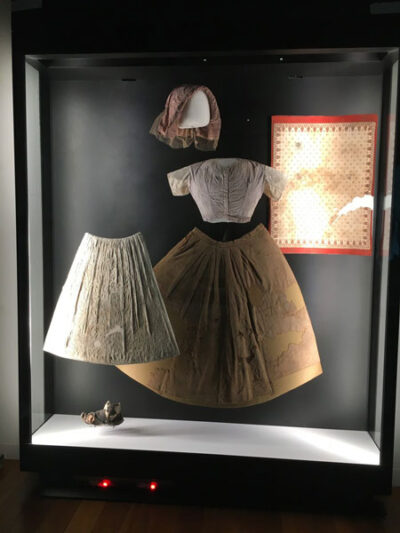
Image: Fragment of a convict skirt, Sydney Living Museum, Hyde Park Barracks
Paper Conservation
Katie Wood and Wendi Powell have been putting into practice the gels training from last year’s AICCM workshop on various types of stains on paper-based artworks. We have also been working on a number of flood-damaged works, from both private and gallery collections. Wendi is continuing to work on the repair of a family bible.
Furniture Conservation
Oliver Hull has been removing a synthetic varnish and re-polishing a very fine regency sofa table. Oliver’s amazing timber skills have also been utilised in reconstructing a collection of damaged Indigenous totems.
Textiles Conservation
In February Senior Textile Conservator Christina Ritschel completed a project for Sydney Living Museum, which had been running over five months. Forty-five textile objects were conserved and prepared for exhibition at the Hyde Park Barracks. There were many highlights, but the fragment of a convict skirt stands out, as it was a massive treatment to stabilise it onto net and then make it come alive on its mount for the exhibition. We highly recommend a visit once when the museum reopens.
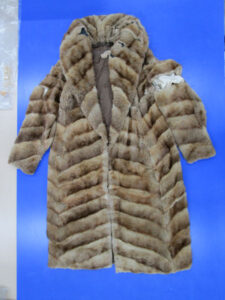

Images: Australian water rat fur coat before and after treatment.
Objects and Outdoor Heritage
The Objects and Outdoor Heritage teams have been busy in the lab and outside it. A sample includes Wendy Reade completing the conservation of Nigel Helyer’s Dual Nature seashore installation at Woolloomooloo, which included the novel experience of a conservator needing to swim out to one element to undertake treatment at high tide (to avoid getting cut on the shells). Nicola Ashurst has been developing policies for the ongoing care of the building finishes at Suzannah Place in the Rocks. Sergio Merida has been restoring a rare set of lacquered bellows for Eryldene and installing a Vanuatu slit drum at the Royal Botanic Gardens.
Museum of Applied Arts and Science
Project and Treatment Update
The Collection Relocation and Digitisation (CRD) Conservation phase continues. Vanessa Pitt has been appointed as acting Senior Conservator, Castle Hill, and is working on a collection of guitars and guitar cases for the Maton exhibition. Currently, there are approximately 110 guitars from the collection located at the Museums Discovery Centre (MDC). Chris Redman is undertaking the treatment of over 300 magic lantern glass slides and Skye Mitchell a series of electrotypes in preparation for digitisation.
The CRD Hazards Management team is assessing collection items suspected of containing a hazardous material. Those confirmed to contain a hazardous material have been documented, labelled, packed and stored in accordance with state and federal legislation. The Hazards Management team has also been working hard to create procedures for the management of hazardous material within the museum’s collection and roll out training to collections staff.
COVID-19 has resulted in several conservation staff working from home. It has therefore been a great opportunity to update conservation guidelines and review current policies and procedures. Lizzie Reed has been updating regional information sheets and the CRD Assessment team collection care information sheets, which will be added to the MAAS Conservation Resources webpage.
Exhibitions
The Powerhouse Museum, Sydney Observatory and Museums Discovery Centre are temporarily closed to the public. Suzanne Chee participated in the de-installation of Step into Paradise and Teresa Werstak in the de-installation of Cue and Shape. Teresa is also involved in the inspection of exhibitions while the museum is closed and, in conjunction with Tim Morris, is working on the refurbishment of the Sydney Observatory. Ralph Boesel has been maintaining the steam engines during the shutdown and working on other steam projects.
Loans
All outgoing loans are proceeding with modified timelines. One of our Chanel gowns will travel to Paris as a key piece in the reopening of the Palais Galliera, the Fashion Museum of the City of Paris, as the first permanent fashion museum in France in an exhibition celebrating the work of Gabrielle Chanel, Manifeste du Mode. A collection of four screen-printed textiles and an acrylic on canvas will also be travelling to Los Angeles for display in an exhibition at the Fowler Museum at UCLA, Aboriginal screen-printed textiles from Australia’s Top End, organised by the Fowler and curated in collaboration with the Aboriginal-owned art centres.
State Library of NSW
Staff changes
In Collection Care, Natalie Cassaniti (DEP team) left the Library to take up a position at the Parramatta Heritage Centre. Natalie will be greatly missed by her team and the branch. We would like to congratulate her on this wonderful opportunity and thank her for contributing to the ongoing success of the digitisation stream.
Professional news
The Exhibitions & Loans team has deinstalled five exhibitions over the stay-at-home period to enable upgrades to be carried out on the HVAC systems in the galleries while closed. The team is also using this time to review the SLNSW loans environmental parameters. These parameters may potentially be broadened to reflect the Bizot protocol. Work continues on preparation for a display of paintings for the Friends Room – private conservator, Michelle Wassell, is working on the treatment of two portrait paintings – A.M.E Bale by Ernest Buckmaster and Dorothy Gordon Jenner by Judy Cassab – planned for the display. Cath Bartley is carrying out an extensive mountboard survey to review choices of mountboard for display and storage.
The Collection Care DEP (digitisation) team continues to prepare material for digitisation projects while working remotely and has been trying to fulfil our project targets. This has involved much planning and discussion with couriers and other Library digitisation staff on key activities such as packing, assessment and treatment of collections before sending offsite.
Hoa Huynh and Keyeele Lawler-Dormer (Kiki) popped into the Library for two days in April to pack negatives from the ACP Magazine photographic archive to send offsite. They also assessed and packed 147 oral history tapes (in poor condition) that had never been sighted before by the team. Whilst this task was considered a success, it highlighted how important it is for staff to examine the physical items beforehand as it will help estimate how long it will take to complete the task within a tight deadline.
Kiki, Hoa and Lang from DEP have also taken this ‘down time’ to undertake a number of online training courses. A significant one for the Library is the Core Cultural Learning online training course. This is the first component of the NSLA Culturally Safe Libraries program, which is aimed at building Aboriginal and Torres Strait Islander cultural competency in libraries across the country.
To keep up their hand skills and practise newly learnt bookbinding techniques, Kiki and Hoa have also set up home binderies. Photographs of these have been published on the Library’s social media to show how we have been working from home (#NSWathome).
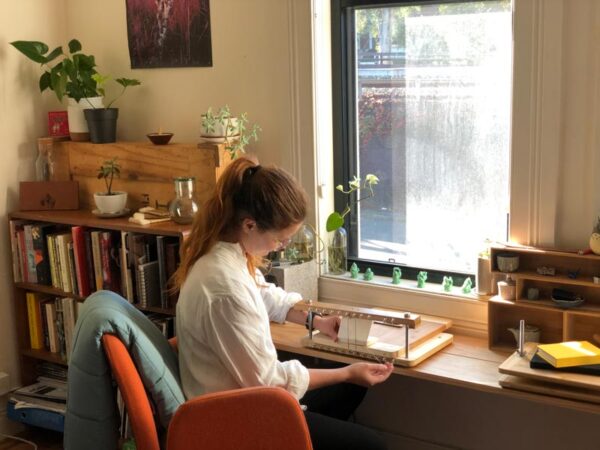
Image: Kiki Lawler-Dormer sewing a signature into a cord binding on her DIY sewing frame. Image: Kiki Lawler-Dormer.
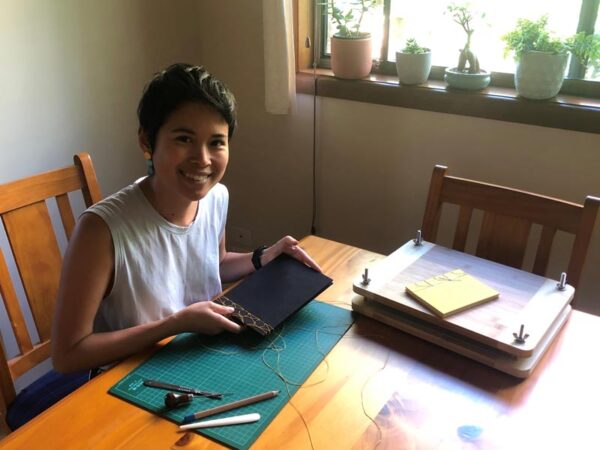
Image: Hoa Huynh finishing the last stitches on a Japanese stab binding. Image: Hoa Huynh
The Preservation team of Aileen Dean-Raschilla, Nicholas Beckett, Paula Thorby, Silvana Volpato and Catherine Thomson has been adapting to working from home: continuing weekly meetings virtually, undertaking a whole host of online training, fine tuning documentation, cross-checking collection lists and thinking up some imaginative ways to keep up their hand skills. Using condition reports and item information found in the Library’s catalogue, they’ve brainstormed rehousing solutions for some of the trickier things in the collection, discussing materials and methods, sketching, designing and making physical mock ups with whatever they have at hand at home. Online training has ranged from sessions on the Library’s research databases to the AIATSIS Core Cultural Learning program. An eclectic mix of conservation online resources has also been explored, with ‘Why do old books smell and other adventures with odours in collections’ having the best title. Some of the team have been able to practise some binding and book repair techniques at home, making notebooks, albums and reattaching boards. There has also been a bit of creativity in online meetings, with a variety of lovingly crafted headwear making weekly appearances.
Research projects
Kiki and Hoa have undertaken a GIS mapping course to assist in research for two ‘Aboriginal Carving’ volumes that the team has been treating. These volumes contain sketches and maps of Aboriginal petroglyphs across Sydney. Helen Casey is working on an artist attribution for a painting in the collection she recently treated of a young Viscount Sydney, believed to be by the 19th century English portrait painter Thomas Hudson. Helen is also researching the colonial artist Maurice Felton as part of a sponsored reframing project of Felton’s works in the collection that no longer have historical frames.
Queensland
Cairns Historical Society and Museum
While the doors have been closed during the COVID-19 lockdown, Melanie has been active in a preventive role as collection manager at Cairns Historical Society and Museum.
She has taken the time to catch up on administrative tasks and look at collection priorities for the next financial year as well as taking a minute or two to enjoy working at the bench uninterrupted by preparing some of the collection material for their next phase, whether it be an exhibition or storage. Melanie reports:
‘The next exhibition has brought some more curious objects into our care, and it was a nice excuse to don the gloves and do some light preparation ready for show when we are ready to welcome the public into the galleries again (images 1 & 2, below).
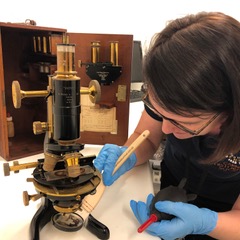
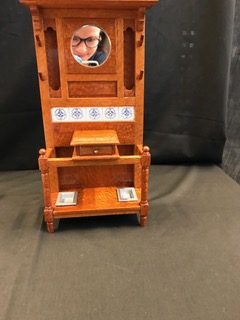
Images: Preparing objects for exhibition.
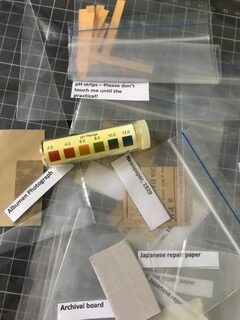
Image 3: Preservation training pack.
‘One of my main priorities here at the society is training the volunteer cohort in collections care. The COVID-19 lockdown has also allowed me a little creativity in the education field. Here at the society, I am a great advocate for training and encouraging those in the group who have a keen interest in materials science. I had devised a one-year plan of monthly training for my group of 13 volunteers in preservation basics; however, the lockdown and cessation of our volunteer program put a temporary freeze on those plans. I have vowed to not let the lockdown derail my plans for collection care and handling training, and so at the minute I have devised virtual preservation training packs (image 3). These packs will be sent out via post to select members of the collection care team for some at-home chemistry fun! In our first session we will be learning about acidity in different paper materials and why acidic materials are a no-no for storing collection materials. These are basic skills sessions, which are pitched at a complete-beginner audience. We will work through technique and terminology used in the industry, starting off with a tour of pH. Each pack contains pH test strips and a range of materials for testing. Using Zoom, participants will go through a practical training session with me to undertake pH testing of the different materials at home. The packs contain samples of different types of papers and materials including box board, newspaper from 1875, washi, archival board and an albumen photograph. Participants will be guided in using the cold extraction method to analyse the pH levels of different types of materials commonly found in collections. This training is all part and parcel to understanding how vulnerable our special collections can be at the material level. The main aim of this elementary training is to get back to basics and to educate those responsible for the collection as to why our housing choices and selections are so important.
‘Stay safe, well and healthy.’
South Australia
Artab Australia
Artlab staff have managed the recent COVID-19-affected months with a combination of working from home, taking leave where possible, and revisiting jobs that have been on hold. It has been a time for following up on long-neglected paperwork, catching up on the backlog of conservation-related reading and up-skilling our IT capabilities – in order to more regularly undertake meetings via video conferencing.
More recently, we have been particularly fortunate that South Australia has managed to reduce the number of active cases of Coronavirus, and there has been a lengthy period with no new cases confirmed. This, together with our spacious laboratories and work areas, and the ability of many to avoid the use of public transport to get to work, has meant that many of us have been able to safely return to the workplace. Of course, social distancing is still being observed and protocols around many activities have changed (and will remain in place) for the foreseeable future. But for many of us at Artlab, some level of ‘normality’ has returned.
Objects Lab staff changes
We are delighted that our staff numbers have increased in the last few weeks as work has started on a major project improving storage at the South Australian Museum’s off-site store. First staff to be appointed are Kenny Monger, Megan Sypek, and Helen Behrens, with four other new staff to begin later in the year. This project will involve all Artlab’s objects conservators in some capacity in the next six to twelve months.
Jo Dawe has relieved Sophie Parker as Head of the Objects Lab for the next few months and is doing a great job, as did Sophie.
Treatment projects
Chandeliers
While many jobs have been postponed or put on hold, particularly with the Art Gallery and Museums being closed, there have been some challenging projects undertaken. Abby Maxwell-Bowen, Justin Gare and Filipa Quintela undertook the removal of two of the chandeliers at Government House recently. As is often the case with older buildings, the process of removal was not as straightforward as hoped. The first, smaller chandelier was removed relatively easily, but the larger unit resisted robustly. Success was finally achieved after a section of the floor above was removed to allow easier access to the fittings/fixing mechanism.
Chinese terracotta bull
Earlier in the year, Megan Sypek undertook a repair on a large Chinese terracotta bull, brought in to Artlab by a private owner. All four legs had been broken in multiple locations and a horn had been broken off (see Image 1). There was evidence of historical repairs. While terracotta repairs are an assumed skill for objects conservators, this treatment was complicated by the size and weight of the item; the bull was approximately 1m long and 0.65m tall. The terracotta at the breakage sites was soft and porous and required consolidating with 5% w/v Paraloid B-72 in acetone. When adequate consolidation was achieved, the legs were adhered in place with 50% w/v Paraloid B-72 in acetone. Megan came up with some clever engineering work involving a network of tape, clamps and blocks, which were used while the adhesive set up (see Image 2). Losses were filled with tinted Liquitex acrylic modelling paste. In-painting such a mottled surface was very enjoyable. To complete the treatment, the bull was padded and packed into a crate for transport home to greener pastures (see Image 3).
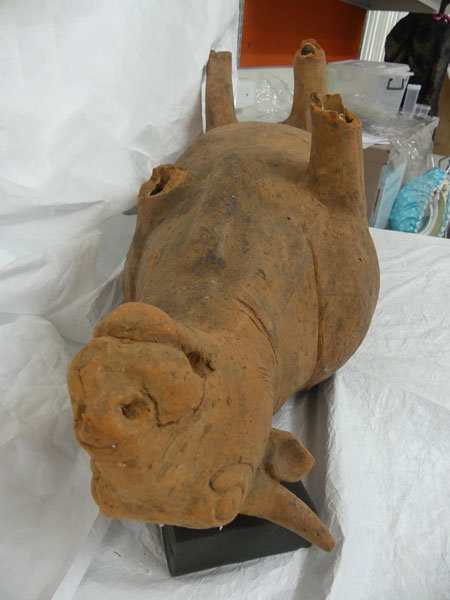

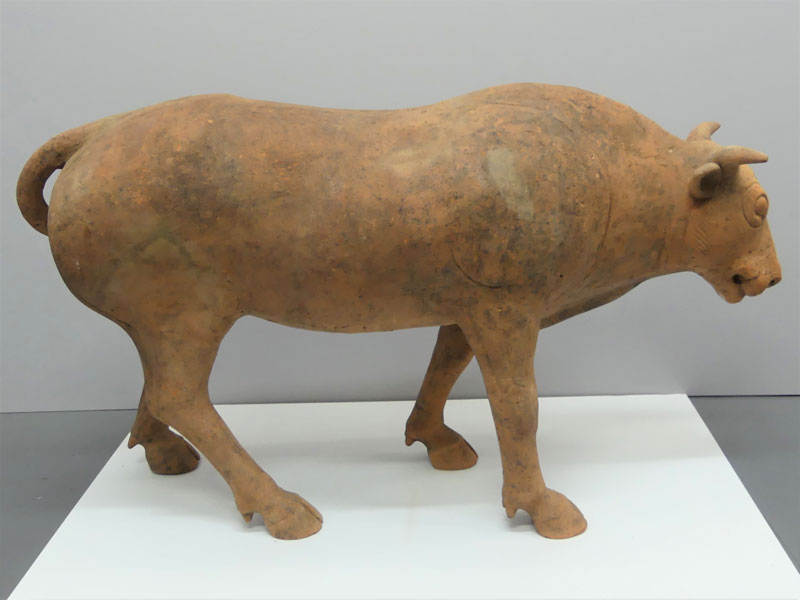
Images 1–3: Chinese terracotta bull before, during and after treatment.
Parian ware figures
Objects and Textiles Conservator, Sophie Parker, carried out a treatment that involved replicating losses on a large item of ‘statuary porcelain’, Parian ware, using calcium carbonate and Hxtal NYL epoxy. Sophie’s description follows.
A loyal client brought in the piece de resistance from his family’s collection in Argentina; a Parian ware group of figures entitled La Marseilles. The aged restoration was very obvious, featuring extensive yellowed overpaint. There were detached pieces showing dark brown adhesive, dowels of rusted wire, and plaster (see images 4 and 5). A full treatment was the goal, reversing the restoration and replicating the losses.
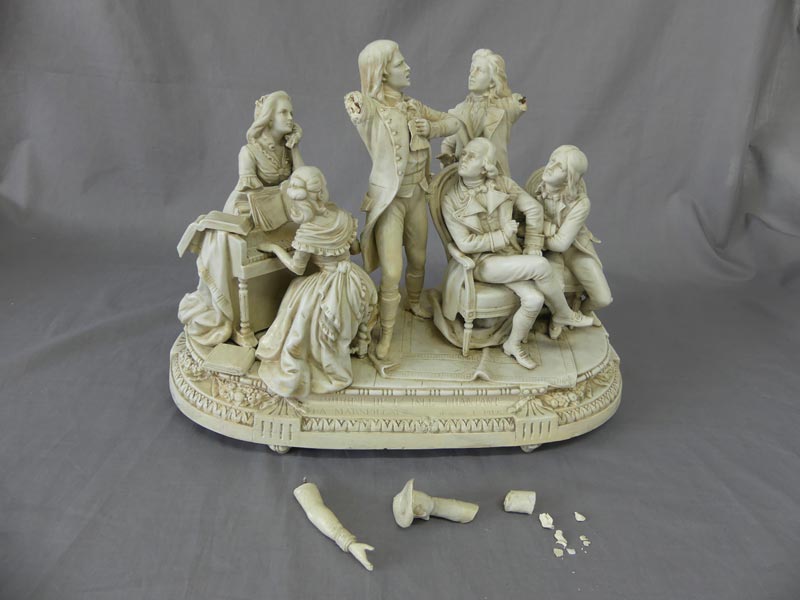

Images 4 and 5: La Marseilles figures, before treatment.
Fortunately, the adhesive and plaster reversed in hot water, and solvent was only required to remove paint residue. The cleaned breaks were numerous, both large and small. They were adhered in stages with Hxtal NYL epoxy resin.
Recipes were trialled for filling losses of the usual mixtures of kaolin clay, fumed silica, glass micro balloons and pigment, with Hxtal NYL epoxy resin. It quickly became apparent that I hadn’t thought the procedure through very well, as the kaolin muddied the mixture despite its very desirable plasticity and I would lose the whiteness and transparency. (Overpainting was not an option.) My colleague Renita Ryan suggested calcium carbonate powder, which had been used in a variety of treatments at the time in the lab (such as polishing silver), and amusingly seemed like ‘product-of-the-month’. Mixed with the Hxtal it produced the ideal whiteness and opacity, and was easily remixed for repeat applications. Unfortunately, it lacked plasticity and partially cured Hxtal was useful for stiffening the mixture, but it still had to be ‘blobbed’ on and worked back when dry with a Dremel drill, files and abrasive papers which made it very time-consuming. It did have flow, and silicone release film and pressure-sensitive adhesive tape were used to support fills to replicate ‘paper pages’ successfully (see Image 7, which shows the detailed repair work, and Image 6, which shows the overall object after treatment).

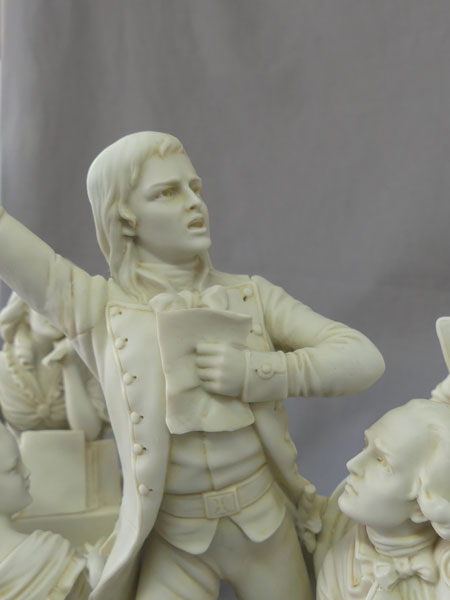
Images 6 and 7: La Marseilles figures, after treatment
We weren’t aware of calcium carbonate being used in this way so wanted to share it as an idea for filling matt, white losses in ceramics.
Vatican parchment rescued from the sea
The Paper & Books department has recently completed the conservation treatment of a parchment document, the bull of appointment of Matthew Beovich as Archbishop of Adelaide under the papacy of Pius XII. The document belongs to the Archives and Records Services of the Catholic Diocesan Centre in Adelaide, and Lucy Farrow, archivist at this institution, brought it to Artlab during one of our consultation days.
A bull is the highest rank of document produced by the Vatican chancery. For the last 600 years papal bulls have been produced with minimal changes in their composing materials, execution techniques and diplomatic text. The term ‘bull’ comes from the Latin word bulla, meaning seal, most frequently made of lead. The seal features the name of the pope on one side and the embossed images of St Peter and St Paul on the other, to replicate the design of the papal ring.
Roberto Padoan, the conservator who carried out the treatment, has worked in close collaboration with Lucy who has provided vital information about the conservation history of the document. Following the notes reported by the archbishop himself, the bull was sent in a mailbag by a Dutch airliner that crashed in the sea near Java in 1939.
Parchment is a skin-based material that can last for thousands of years if kept at the right climate conditions—the 2000-year-old Dead Sea Scrolls being a clear example—but in this case the document was exposed to extremely high temperatures and it underwent a full immersion in salt water. This dramatic combination of events brought the edges of the parchment to an irreversible stage of gelatinization, causing the rest of the document to shrink and loose flexibility.
After the document was rescued from the sea, it was ‘restored’ in an attempt to make it readable again; most likely by applying a paper layer on the recto. Although the first result appeared to be very satisfactory at the time of the intervention, the deterioration process continued during the last 80 years, rendering the document extremely brittle, deformed, fragmented and impossible to read (see Image 8, before treatment).

Image 8: Vatican parchment before treatment.
The conservation treatment conducted at Artlab included various stages: relaxation under controlled humidity; stabilisation of tears and missing areas from the verso, with Japanese paper; tensioning on a frame; infilling; mounting on a rigid board and boxing.
As it was essential to maintain the humidity levels as low as possible during the treatment and to minimise the risk of environmental shock, the relaxation and tensioning stages were carried out slowly – over a period of three months. This allowed the parchment to gradually adapt to changes (see images 9 and 10).


Images 9 and 10: Vatican parchment during treatment: stabilisation of verso before stretching; stretching in frame.
Finally, the parchment was flow-mounted on a buffered museum board with Japanese paper hinges and cotton strings to hold the seal in place. A rigid backing support of foam board and museum boards was created as a backing structure to ensure that the actual position would be maintained inside the storage box (see Image 11, after treatment).
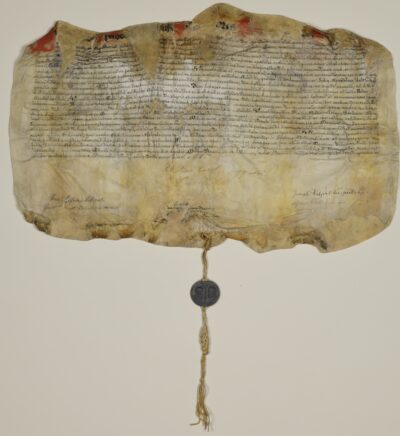
Image 11: Vatican parchment, after treatment, mounted on conservation board.
Book Conservation Services
New Conservation Practice in Australia

Image 1: Adelaide conservation bindery.
Book Conservation Services is now nestled within the Adelaide Hills, South Australia (images 1 and 2). After closing the conservation bindery in 2016 to pursue overseas work and studies, owner Karen Vidler (PM AICCM) re-established her small private conservation practice in Adelaide with the usual design considerations when establishing a new studio space.

Image 2: One of several resident koalas that hang out outside the bindery.
This is the fifth conservation studio Karen and her multi-skilled and long-suffering hubby, Brendan, have set-up since first establishing Book Conservation Services in 2006. The current space comprises the space usually occupied by a three-car garage and two workshop spaces under a house, which is built into the side of a hill. With this location comes a new set of problems to be solved, such as heating and cooling and sustainable pest control. In this instance blunder traps (Image 3) are located throughout the studio space and are checked weekly and changed every two to three months depending on the seasonal local traffic.

Image 3: Blunders traps: (L) external door, (M) storage shelving, (R) materials storage.
The new studio was opened in August 2019 with an open studio day (Image 4). Thankfully, lots of people attended to show their support and take a sticky beak around the new space. Staffing includes Karen, the senior conservator and owner, Lynne who is responsible for administration, and an intern (more about this later). Lynne is also completing a training exchange, which involved learning new skills in bookbinding and book repair in exchange for undertaking simple preventive conservation work for the clients.

Image 4: Book model display during open studio 2019.
Apart from performing book and paper conservation, the business continues to offer small group workshops, tailored tuition and an annual internship program.
This year’s intern is Amalia Ranisau (image 5), a student undertaking the Master of Cultural Materials Conservation, University of Melbourne. Amalia already has significant conservation hand skills and knowledge from her work at the State Library of South Australia and private practice, which is being built on during her one-year internship in book and paper conservation.

Like many private conservation practices around the world the COVID-19 pandemic has caused a pause in client visits, workshops and internships. The practical bench conservation work continues for Karen (image 6) and over the coming months the workshop program will recommence, as will Amalia’s internship training.

Image 6: Treating a gilt leather book cover.
Karen Vidler (PM AICCM)
Tasmania
Applied Conservation Science
COVID-19 has had a big impact on business in the private conservation sector, with essentially all interstate and international projects paused indefinitely. It remains to be seen if local activity will grow this year, or if governments will invest in heritage preservation projects as part of community recovery strategies.
Activity at Applied Conservation Science has been focused on further building and facility improvements, including the installation of key pieces of equipment such as a metal lathe and milling machines for custom component and support manufacture. There has also been good success with the integration of Prusa 3D printing systems, and these cost-effective machines produce surprisingly high-quality prints of 3D scanned or custom-designed components. The other main success has been the completion of the fit out of a small on-site accommodation flat to enable progression of our business model of having interstate and international specialists working in Tasmania on projects that might not otherwise be financially practical. When restrictions lift it is also hoped that we will be able to offer on-site free accommodation to facilitate student and graduate internships as a part of growing capacity and giving back to the continuance of the profession.
Current treatment projects are a Salvador Dali artwork damaged in transit from Paris, and the removal and packaging of a 12-metre-long Antarctic ice-core drill from a Hobart building for display at a new location. This important piece of scientific equipment was central to early experiments that demonstrated atmospheric gas concentration change due to human activities.
Research work has been focused on a project to make use of the nuclear isotope decay rate counting capability of the Australian Lucas Heights reactor to further progress the idea that nuclear decay of specific elements within cast bronze objects provides an accurate internal clock that supports a casting date determination. This will be an important measure in helping to establish a new hurdle for counterfeit bronze sales, as so far not many forgers have access to nuclear reactors to enable them to beat such a test!
Additionally, development work of an environmental monitoring system for museum applications has progressed. The design for a sensor pack, using new generation electronics, is nearing completion. It will monitor temperature, pressure, lux hours (and possibly spectral intensity), oxygen concentration, relative humidity and possibly additional parameters. A key component of the design is a new method of measuring oxygen concentration developed in Cambridge that provides in excess of five years calibrated sensor life down to 0.25% oxygen content and 0.1% accuracy because it does not use a corrosion cell to measure concentration. This system will upload data over Wi-fi for collection anywhere online, and be applicable to the new design of oxygen-free display cases currently under development, as well as providing certainty for low-oxygen pest treatments or monitoring remote exhibitions or storage of high-value objects. Development has been delayed due to international transport and manufacturing limitations in China; however, hopefully a full announcement will be available in the near future.
Small business in the conservation profession has become a high-stakes game in the current economic environment. Hopefully many of us survive and are able to continue to provide a valuable service to the many private custodians of important cultural heritage.
Libraries Tasmania and the Tasmanian Archives
Current Projects
Our COVID-19 experience has been very favourable for us so far! With just two of us in the lab, we can maintain social distancing easily. Many of our library and archive colleagues are working from home while the institution is closed. This means that we have been able to focus on making a dent in our considerable backlog of work, which is often cast aside for exhibitions, loans and assistance for access to fragile and vulnerable items among many other demands.
Gaynor Tollard (Conservation Officer) has reframed a watercolour of Rouen Market by Lily Allport, a new acquisition for the Allport Library and Museum of Fine Arts. The frame was treated last year by Louise Bradley.

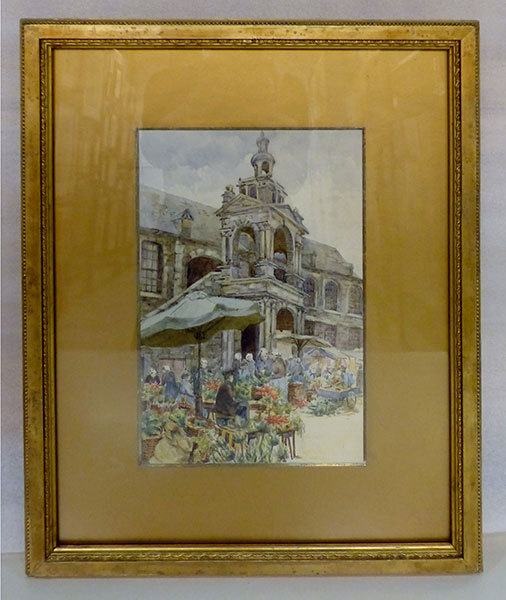
Image: Sketch in Rouen Market attr. Lily Allport.
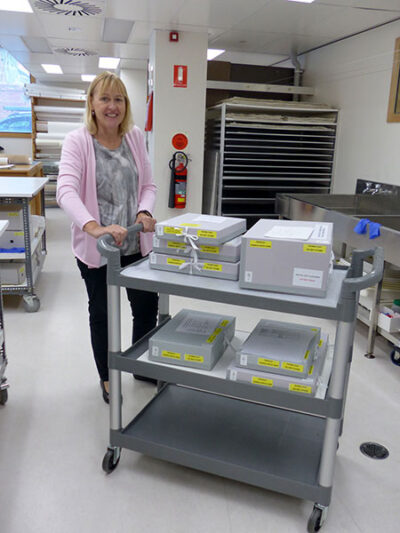
mage: Gaynor with a trolley-load of custom-made boxes and records to return to stack.
Gaynor has also been in full production of custom storage boxes for a wide range of fragile and unique archive volumes and records such as Lower Court records, Surveyor General records, Van Diemen’s Land records and records of prisoners from our Gaol Dept. series.
Stephanie McDonald has been finishing off a number of projects including re-housing glass plate photographic items, Latrobe Council plans, Railway records that had been in a fire and James Ross Hobart Town almanac for 1832.
Exhibitions
We assisted artist Lauren Black with the installation of her exhibition A Complex Beauty, which opened in the Allport Gallery at the end of February. Unfortunately it was only on show for less than a month before the library closed to the public. We have since been helping to work with Lauren organising a greater virtual presence for her show, which will be online soon. Currently, her wonderful exhibition can be seen here
Volunteer stories online May 2020
Volunteer week is coming up soon and our volunteers were busy up until the pandemic arrived and they had to stay home!
In the last year, we have had Miff, Damian and Antonia helping with a range of projects, predominantly re-housing of archival material. We have very specific expectations of our volunteers: they must have excellent manual dexterity and attention to detail – and usually be a little bit obsessive!
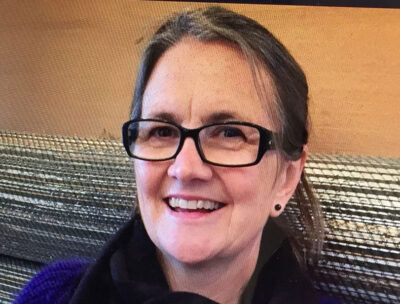
Image: Miff
Miff Fry has been coming in one day a fortnight since March 2019.
‘I have a great interest in historical documents, photographs, objects and art. I was inspired by a family archive I inherited and wanted to learn how to look after it. Volunteering is a great way to learn new skills and to help out in a busy department. The added bonus is you get to work with really interesting, inspiring and fun people!’
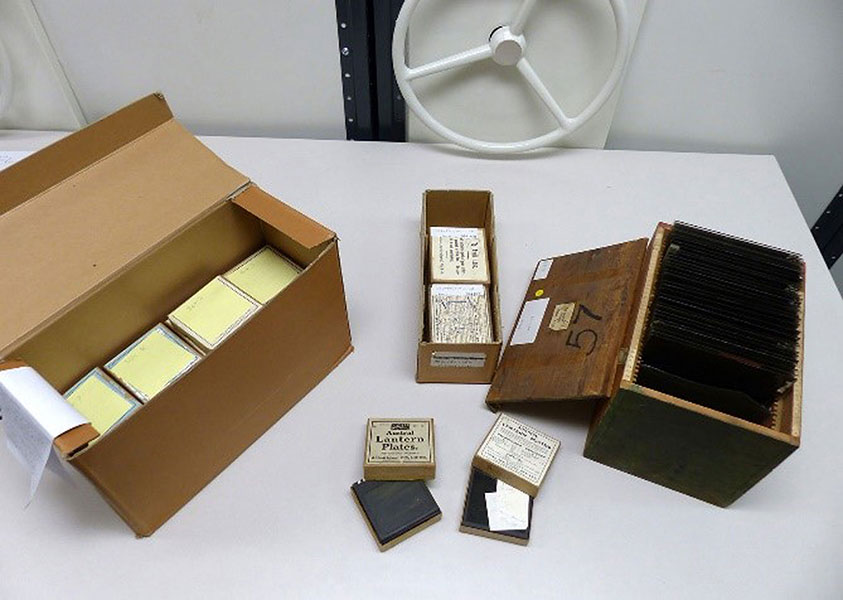
Image: Glass plate photographic items before re-housing.
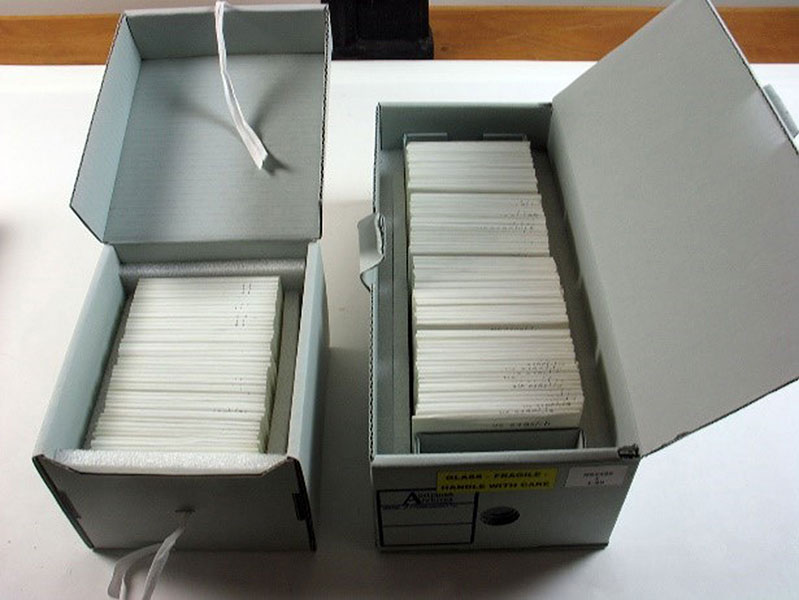
Image: Glass plate photographic items after re-housing.
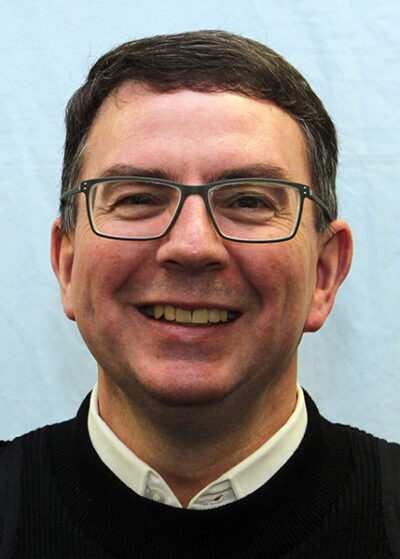
Image: Damian
‘I have always loved libraries. I was journalist at the Mercury newspaper and very quickly developed a passion for the photo files in the newspaper archive, and loved writing articles with a historical perspective. When I found myself with some time on my hands after leaving full-time work I expressed an interest in carrying on the work of Janifer Smith, who had been volunteering in Conservation to identify, catalogue and properly store glass and film-based negatives in the Mercury collection, which was transferred to Libraries Tasmania in 2012.’
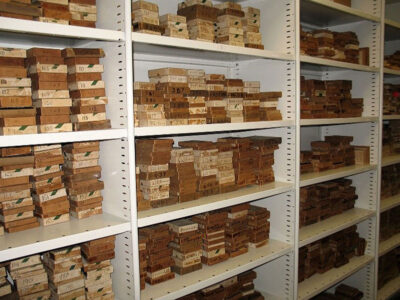
Image: Mercury collection glass plate storage before re-housing.

Image: Mercury collection and other series glass plate storage after rehousing.
Antonia Papasergio volunteered from November 2019 to February 2020.
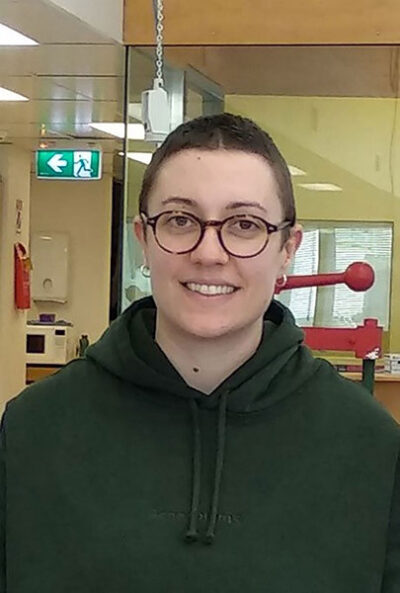
Image: Antonia
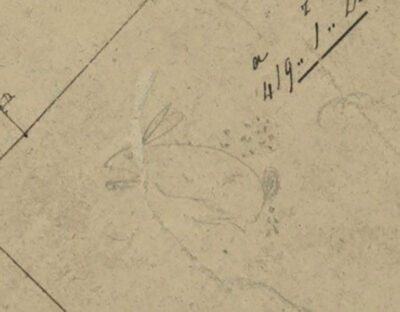
Image: Detail of Betsy Island map 1904 AF396/1/224.
While volunteering in Conservation ‘I had a lot of different, useful, and rewarding tasks to undertake, which included rehousing items, labelling, photographic documentation, and sewing book-support covers. I undertook the rehousing of some old DPIPWE maps, which dated all the way back to the early 19th century, showing topographic and man-made features around Tasmania. All of the maps I worked on seemed to my modern eye quite painstakingly intricate, and it was exciting finding little novelties on them. My favourite by far was a map of Betsy Island from 1904, which included a cute pencil-drawn rabbit, while the Mercury clipping attached to the map explained the not-so-cute decision to hunt the silver rabbits for their skins. Volunteering in the Conservation department was such a worthwhile experience, and has provided me with experience, confidence and motivation to pursue postgraduate studies in conservation.’
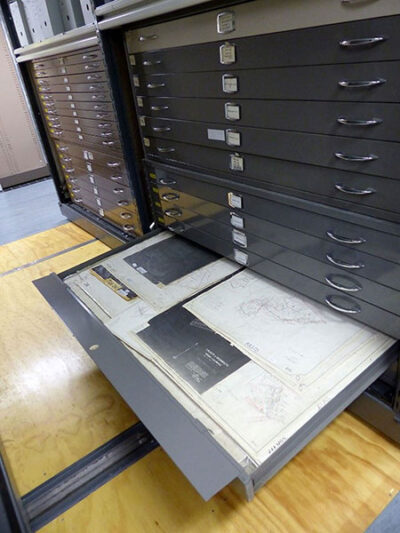
Image: DPIPWE plans (drawer 5) before re-housing.

Image: DPIPWE plans (drawer 1) after re-housing.
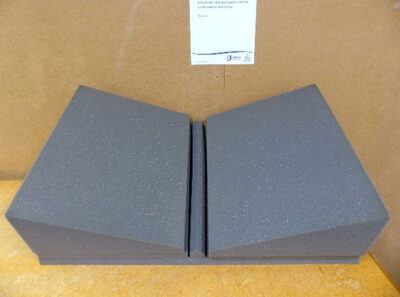
Image: Book-support foam wedges without cover.

Image: Book-support foam wedges with cover made by Antonia.
Tasmanian Museum and Art Gallery
We have managed to adapt to the COVID-19 world. Some of us have continued to work on our different sites, observing social distance and having reduced numbers of people around. Others have alternated working from home and on site.
Paper Conservator Cobus van Breda has been more elusive than usual, spending most of his time in the Paper Lab cleaning over 300 glass plate negatives rescued from the tip, preparing an exhibition (not sure for whom or when!) of botanical drawings by Stephanie Dean and working on some watercolour portraits by Thomas Griffiths Wainewright. The latter have proved something of a challenge!
Painting Conservator Jenny O’Connell was working from home for two weeks of self-isolation following a trip to Melbourne to inspect paintings by David Keeling for an upcoming TMAG exhibition. Upon her return to the museum, Jenny and Conservation Technician Lisa Charleston embraced the uptake of digital content by taking a tour of the labs via Facebook Live.
Busy time for Object Conservator Nikki King Smith in the days of lockdown. The central gallery exhibition has been demounted, and all the material prepared for freezing and storage. New storage racking is being built for the Zoological collection, including the Tigers and the Thylacine collection, a significant improvement. The push for compaction in collection stores has required us to be a bit canny about how we store our collections from now on. To that end, there has been a significant project to reorganise the storage racking in the Large Object Store at Moonah. New racking and slight reconfiguration of existing racking have given us significant space improvements, and the consolidation of collection items onto pallet racking has meant we have made the collection more accessible and safer. The Moonah Large Object Collection Store will also be the recipient of some new roofing, which will be an improvement and means we can take the away the buckets!
Conservation Technician Lisa Charleston is finding COVID-19 shutdown a productive time. With TMAG’s Visitor Services Officers redeployed across the museum, there is capable assistance for progressing many long-view projects, some organisational in nature, others involving vacuum cleaners and plenty of Kunststoff! The Undocumented Frame Survey is really moving at an unprecedented pace.

Image: Nicole, Karen and Lisa doing case maintenance/cleaning.
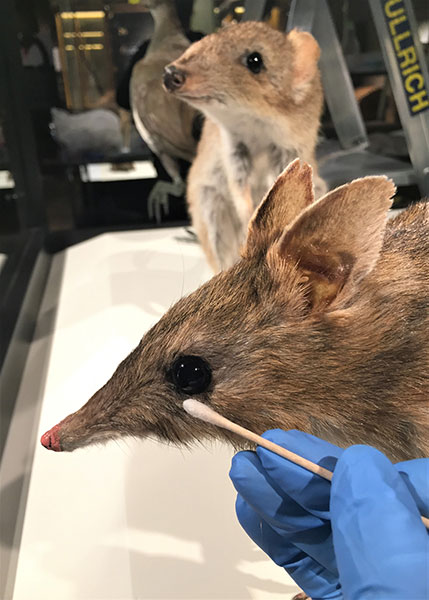
Image: Cleaning eyes.
Victoria
Grimwade Conservation Services
Operations during COVID-19 restrictions
Following Victorian Government advice to stop the spread of COVID-19 in the state, Grimwade Conservation Services paused operations at our North Melbourne labs on 25 March and began working from home. Prior to leaving the labs all treatments currently in progress were secured and impacted clients were notified. A number of staff have been able to continue treatment work outside of the labs following client approval and a review of work practices to ensure new health and safety protocols are strictly maintained.
The Objects team has excelled with the continuation of business as usual in this new home-based environment with Objects Conservation Team Leader Holly Jones-Amin developing an extensive working-from-home protocol for archaeology, approved by both the client and Heritage Victoria. This new protocol has allowed three of the objects team to continue to work on the treatment and documentation of a limited number of objects at home.
Outdoor sculpture treatment has also been approved to continue with Evan Tindal and Jordi Casasayas spending a number of weeks treating a pair of timber sculptures by Melbourne artist Bruce Armstrong whilst adhering to social distancing protocols and wearing appropriate protective equipment when handling surfaces outdoors. They were also able to dial into weekly Zoom meetings whilst onsite and quickly became the envy of the rest of the stay-at-home team.
This time out of the labs has also allowed our team to extend our research work and professional development by pursuing online courses. Peter Mitchelson has recently submitted a book chapter, co-authored with Christine Mizzi and Lois Waters, on the Georgiana Houghton works held in the Victorian Spiritualists Union collection. Peter has also been working on another publication with objects conservator Marica Mucic on pest control and anoxic environments.
Many of the team have noted some curators have used this time in lockdown to review their collections. Treatment enquiries and consultations are continuing and have now been adapted to be delivered virtually via Zoom. Our paintings team in particular have received a number of inquiries whilst working from home as curators and private individuals use this time to assess their collections and future exhibition plans. Once back in the lab, the paintings team will finalise conservation treatments on several paintings in preparation for the Ian Potter Museum of Art re-opening in 2021 as well as a number of other emerging projects.
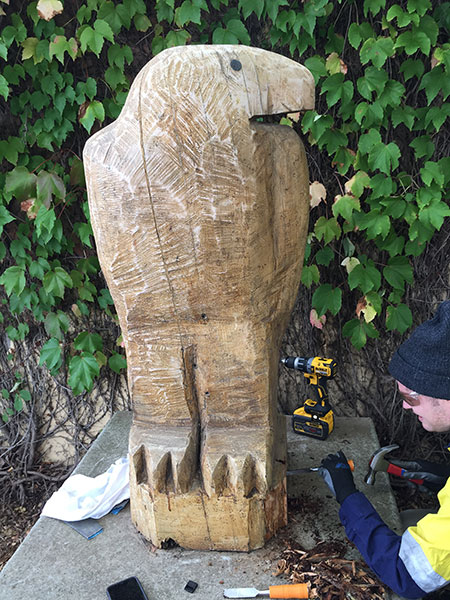
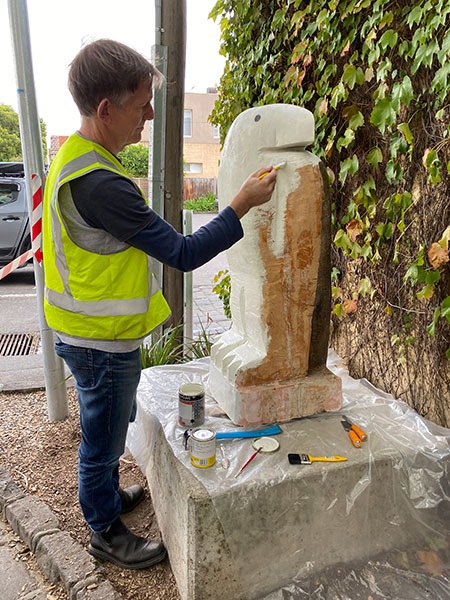
Image 1: Evan Tindal and Jordi Casasayas completing treatment on ‘The Birds’, a pair of timber outdoor sculptures by Melbourne artist Bruce Armstrong.
Responding to emergencies
In-person response to collection emergencies has continued during COVID-19 restrictions and the team at GCS has responded to a number of client calls. Paintings Conservation Team Leader Cushla Hill and Caroline Fry undertook on-site assessment of vandal damage to an important Aboriginal collection, and there has been an increase in pest infestations to a number of collections.
New staff
Penny Tripp has joined Grimwade Conservation Services as our new General Manager, replacing Chris Stevenson from the University of Melbourne Commercial team. Penny has a curatorial and commercial background and formerly held senior executive roles at the National Trust of Australia (Victoria), Caulfield Grammar School and Victoria Racing Club. Penny started in her new role on 24 February. We would also like to extend a tremendous thank you to Paper Conservation Team Leader Libby Melzer for stepping into the General Manager position in the interim between Chris’ departure and Penny joining the team.
May Day webinar
To celebrate May Day on 1 May, our new General Manager Penny Tripp, collections consultant Margaret Birtley and Grimwade conservator Noni Zachri presented an AMaGA webinar called ‘Caring for Collections during Closure’. The session provided over 120 participants from Australia and New Zealand with insight on managing the operational aspects of a lockdown, working from home activities, as well as general health and safety considerations that we may need to employ with handling collections during the COVID-19 pandemic. Grimwade conservators Evan Tindal and Cushla Hill joined the webinar Q&A panel to answer questions.
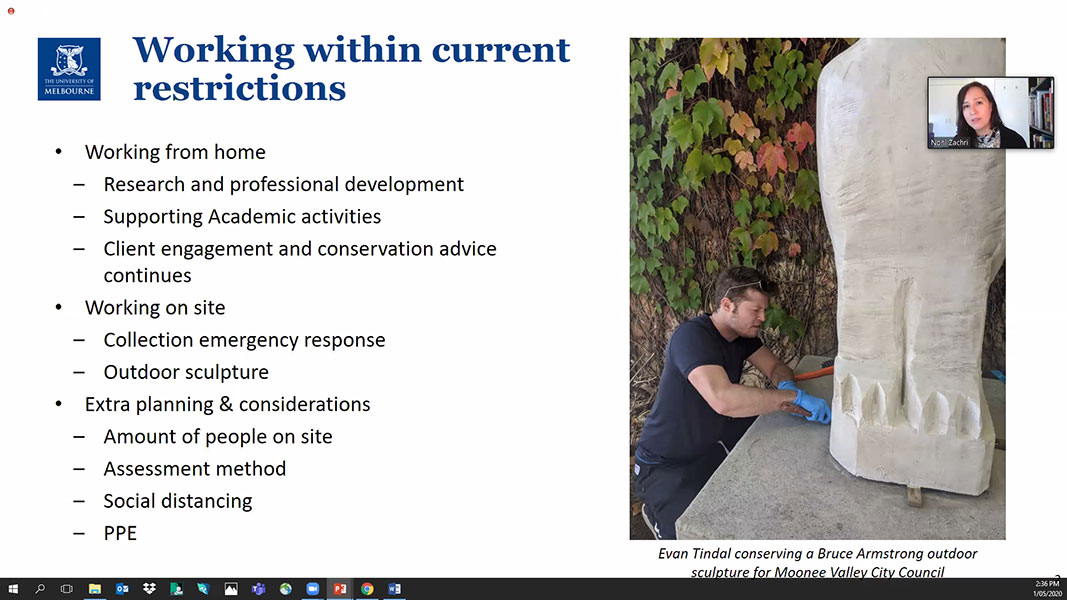
Image 2: Noni Zachri discussing practical considerations for handling heritage material with the current COVID-19 restrictions.
Grimwade Centre Academic Programs
Like all of us, the Grimwade Centre for Cultural Materials Conservation moved quickly to adapt to the lockdowns, social distancing and the way we interact with our students, staff, cultural materials and the contexts we inhabit. We’ve shifted from partial to full off-campus activities in the teaching, learning and research space, and embraced the digital in our online teaching, movie making and editing, and Zoom has become our best ally. This has been challenging and trying for all of us including our master’s students, PhDs, academics and practice-based conservators but has also given us time to reflect on our programs and graduates.
The lockdown coincided with our second-year treatment subject finishing, so our master’s students could quickly wrap up their treatment projects and work at home on their reports, while our incoming first years shifted to online learning in the subject RESPECT led by Robyn Sloggett and Robert Lazarus. RESPECT engages with guest lecturers who have cultural expertise and knowledge, and who lead students through the complexity of issues relating to context and disruption, which COVID-19 acted out. Nicole Tse is now teaching Preventive Conservation with the theoretical content, videos and group activities online and, when we return to campus, practical boot camps for our students to engage with the practical skills in the subject. We are very thankful for our guest lecturers and professional conservators MaryJo Lelyveld (NGV), Elizabeth McCartney (MV), Sabine Cotte (Private Conservator) and Caroline Kyi (Private Conservator) who each share their special area of expertise in Preventive Conservation. We are all learning new digital skills, and as we all Zoom into online conservation learning and meetings, conservation thinking has never been so geographically distributed, disrupted and challenged. In doing so, Petronella Nel, is also busy refining the online content for the materials-science based subjects, which have been part of her subjects for many years, and then developing social distancing guidelines for the practical sessions when we return to campus for practical boot camps. Jonathan Kemp is pursuing new grant opportunities with Canada and Laos, and is gearing up to purchase a conservation laser cleaner soon. Our PhD students are working hard with greater independence in their topic areas, while we are truly missing some students who have been caught up overseas in transit (and are waiting …). So too is Dr Gea Parikesit, our Asia Fellow from Indonesia, with expertise in engineering, physics and performance, who was due to arrive for three months this year. Good news though is the award of an ARC Linkage Project with Gea and Nicole on the 3D printing of custom musical instruments for heritage and industry needs (with lead Prof Aaron Corn from the Elder Conservatorium of Music at the University of Adelaide).
What this is teaching us is the importance of adaptability in our teaching and in conservation practice. Hopefully, a positive outcome of our recent experiences will be a heightened sense of resilience, an evaluation of what is important and knowing what is worth preserving for ‘whom, what, why and when’.
ICS Melbourne
It’s been full steam ahead for the Melbourne team (albeit with plenty of hand sanitiser and distancing of microscopes and benches) who recently welcomed two casual appointments, Celeste Wing Young and Bronwyn Tulloh, to assist with the final stages of the Metro Phase 1 archaeological conservation project being led by Kristine Allinson and Bruno Bell. Frances Paterson, together with Karina Acton, is working with Ballarat City Council on an interesting investigative study of a local War Memorial. The team is also about to commence the preparation of objects and mounts for a new archaeological display to be installed in Melbourne CBD next month.
National Gallery of Victoria
General news
As with many galleries and cultural institutions, the National Gallery of Victoria has been closed to the public since March, and we have been working remotely since 16 March. In the transitional weeks leading up to off-site working, we very quickly planned technology, software and tasks that would ensure everyone could still complete their work and stay connected. Following closure, the NGV Conservation department undertook collection and loan care activities such as the coverage of at-risk collection works, turning off or redirecting lighting in gallery spaces, and covering collection and loan items in back-of-house and storage areas. A maintenance regime document was made to aid conservation staff’s oversight of display items.
Social news
In isolation we have continued with our lunchtime brown bags, virtually meeting and discussing some research and working-from-home highlights. Activities such as weekly coffee catchups, an Easter Zoom and a quilting circle, have kept the department connected during this time.

Image: Morning tea, week two of WFH arrangements.

Image: The collection taking a well-earned rest.

Image: Works with dust and light covers.
Events, outreach and online initiatives
Head of Conservation Michael Varcoe-Cocks and Coordinating Conservator MaryJo Lelyveld have held two webinars in partnership with Public Galleries Association of Victoria. The first online webinar was held on Thursday 30 April with the second on Thursday 7 May, focusing on the topics of returning to work post-closure and disaster preparedness and response. Both webinars attracted 34 attendees. Eighty-nine percent of responses to an evaluation survey rated the session ‘Excellent’ with such comments as ‘Thank you both for delivering a really informative session!’ and ‘it is reassuring to be engaged with a network that can support each other going forward.’
Conservation Project Officer Jessica Lehmann has been coordinating the department’s contributions to outreach and digital engagement programs including: NGV Channel, Instagram, e-newsletters and NGV Magazine, as well as contributing to NGV Online events and media pieces as appropriate. You can read some of our contributions listed below.
A scrap album worthy of a fancy dress by Textiles conservator Kate Douglas
Illuminating: conservation of neon lights by Objects conservator Trude Ellingsen
Lady Elizabeth Hamilton’s hidden gesture by Senior Paintings Conservator Carl Villis
Paper Boy by Head of Conservation Michael Varcoe-Cocks
And in The Age newspaper: ‘In the cold dark of the shuttered NGV, a conservator worries over dust’. Read here
The National Gallery of Victoria is rolling out a series of online events to the public over WebEx events, which can be signed up to via the website. Conservation involvement includes Michael Varcoe-Cocks presenting on Shearing the Rams and Senior Paintings Conservator Carl Villis presenting with Ted Gott, Senior International Art Curator, on the 15th-century Italian cassone panel Trajan and the Widow.
Check out @ngvmelbourne Instagram for rolling Conservation department updates, including previous stories archived under the ‘Conservation’ highlights.
In the May|June edition of NGV Magazine our department wrote a large array of fascinating articles to explore including:
- ‘Conservation & Colour feature: Artists pigments’ by Painting Conservator Raye Collins, ‘Colour matching textiles’ by Senior Textiles Conservator Skye Firth, and ‘Gold in frames’ by MaryJo Lelyveld
- ‘Women in the collection’ by Conservation Project Officer Jessica Lehmann
- ‘Conservator’s insight: Korean screens’ by Senior Paper Conservator Ruth Shervington
- ‘Conservation research into Marcel Jean Spectre of the gardenia’ by Objects conservator Trude Ellingsen
- ‘Hugh Ramsay reframing’ by Frame maker Jason King
- ‘Caroline Broadhurst’s Ivory bangle with silver pique work’ by Objects Conservator Trude Ellingsen
- ‘Japanese fan mount system’ by Mount maker Benjamin Raynor.
You can peruse the last 12 months of NGV Magazine issues online (FREE) here
Treatment projects
During the closure there have been very few opportunities for staff to continue their treatment projects, however Michael Varcoe-Cocks has taken the opportunity to do some surface cleaning of a large 19th-century painting Departure of the Pilgrim Fathers by Charles Cope.
The major restoration treatment of the Cope frame was unable to continue at his time; however, AGL Shaw Assistant Conservators Bella Lipson-Smith and Dominic King took on another exciting project, for the NGV Centre for Frame Research, working from home. Dom and Bella completed the mammoth job of transcribing the ledger of Melbourne frame-maker John Thallon (covering the period 1888/89–1903). The resulting spreadsheet includes 2392 lines and 20 columns of data, 200 photographed sketches, as well as research on around 190 of Thallon’s clients. Sadly, Bella and Dom’s contracts were completed at the end of April but we hope to see them again at the NGV in the not too distant future.
Frame maker Jason King has been busy since closure with a home studio set-up and frame making including gilding samples, creating ornaments for a McCubbin frame and completing construction and finishing of a double-sided frame for a Francoise Gilot new acquisiton.
Ellen Doyle and Di Knight in Textiles conservation sewed and designed covers for loaned and collection works.
Objects conservator Marika Strohschnieder completed the conservation treatment of a late 16th century polychrome wood shrine. A 16th century polychrome Madonna and Child and a 19th century marble sculpture Amore Accieca by Donato Barcaglia are Marika’s current treatments.
Research projects
Textile conservator Kate Douglas has been carrying out historical research on the trade of Indigenous animal furs in the 19th century. Focused on quoll fur, the research will coincide with the treatment of a quoll fur carriage rug.
Objects conservator Dianne Whittle has a research project underway, which focuses on digital imaging, primarily 3D-scanning and 3D-printing – with practical application to the conservation of objects.
Objects conservator Trude Ellingsen is currently undertaking some research around crystals and has started to grow her own! Senior painting conservator Carl Villis has used the opportunity of working from home by writing articles, essays and chapters on two major work research projects: the new MS3 varnish resin co-developed with Deborah Lau and her team at CSIRO, and a book on his discovery of the NGV’s Renaissance portrait of Lucrezia Borgia.
Painting conservators Raye Collins and Raymonda Rajkowski, joint convenors of the AICCM Paintings SIG, have continued to develop plans for the upcoming Paintings SIG symposium to be held in Melbourne in 2021. Meanwhile Raye has continued her research into mid-20th century artists and artistic practice, with a focus on painters such as Herbert Badham, Constance Stokes, Grace Crowley and Ralph Balson, and has contributed articles on these artists for NGV Magazine and media outlets.
Similarly, Raymonda is contributing articles for NGV Magazine and media relating to her outreach to living Australian artists regarding materials and techniques. From home she is also overseeing the continuing exhibitions, acquisitions and loan processes for the Gallery’s Indigenous paintings.
Caitlin Breare has been the co-ordinator and primary author of the Gallery’s new online catalogue of British painters and has used the gallery closure to research the materials and techniques of several artists that feature. A particular focus has been John Constable, of whom the NGV has up to six paintings. She has also prepared an undergraduate online lecture and NGV Magazine article on recent treatments.
Michael Varoce-Cocks and MaryJo Lelyveld have been working with the NGV Facilities staff to implement Bizot Green Protocol environmental settings across collection areas at NGV-I including gallery and storage areas. As part of this transition, Holly McGowan-Jackson and Suzi Shaw have been working with the NGV photography department to visually document surface condition and cracks in responsive furniture collection works. The shift to wider environmental settings is delivering a considerable saving to building running costs, especially during this closure period.
Suzi Shaw is developing artist questionnaires to enable them to work across the different sections of the department and has written an article on traditional storage boxes for Japanese artworks.
Exhibitions
Although there have been changes to the exhibition program, Exhibitions and Loans conservators Catherine Earley and Janelle Borig have still be busy in overseeing the de-installation of the KAWS and Haring Basquiat exhibitions. Before closure at NGVA they installed the Destiny Deacon retrospective DESTINY, which is planned to be opened in December, and de-installed the Roger Kemp exhibition.
Following a major review of the exhibition schedule due to the impacts of COVID-19, conservators are re-scheduling the treatment and mount and frame preparation for collection and loan works for the latter half of 2020 including: Tiwi: Art of the Crooked Painting, Big Weather, various Triennial 2020 projects and changeovers for NGV-A and NGV-I permanent collection galleries and Members Lounges.
Student Conservators @ Melbourne
AGM
We would like to introduce the committee for 2020. On 5 March, we held our AGM at The Clyde Hotel to vote in the new committee who are:
Belle Williams – President
Rachel Davis – Vice President
Issy Legg – Secretary
Jen Parker – Treasurer
Phoebe Ignatia – Projects/Events Officer
Paul Coleman – Projects/Events Officer
Imogen Colton – Sustainability Officer
Katherine Pigott – Communications Officer
Alisa Blakeney – Communications Officer.

SC@M 2020 committee (from left): Katherine Pigott, Imogen Colton, Phoebe Ignatia, Belle Williams, Rachel Davis, Issy Legg, Alisa Blakeney, Paul Coleman, and Jen Parker.
A big thank you and congrats to last year’s committee for their achievements!
Drinks @ the Dock and Trivia Night
In the life before COVID-19 restrictions, we hosted some successful events such as Drinks at the Dock and Trivia Night. Drinks at the Dock is a traditional chilled social evening held out the back of the Grimwade Centre. This year it helped to introduce the freshly started first years with the second years who were heading into treatments. The Trivia Night in February was a fun way to raise funds for Bushfire Relief and keep a tradition going. We raised over $300, which was donated to Wildlife Victoria. A big thanks to everyone who came out for the night.
Looking forward
During the pandemic of COVID-19 student life has changed dramatically. The labs were closed at the Grimwade in March and classes that could, transitioned to the online platform. Many second years were not able to finish treatments and first years delivered presentations from home.
Many students have had to move back home to other areas of the country.
The pressure of study remains the same if not heavier with these changes and with the closure of all facilities it is harder to focus.
It has been a time of struggle but our team has been staying connected and encouraging each other with understanding.
The 2020 committee’s first and quite enthusiastic 2020 SC@M meeting was held in-person at the Clyde before restrictions took place. And while some plans from that meeting have had to adjust in light of COVID-19, SC@M’s goals for the future are still the same.
Adjustments have taken time for students and staff alike, as we were not prepared for these sudden changes. Online events will be taking place until we can regroup in person. We are excited to be working with the AICCM Emerging Conservators SIG to bring a series of webinars to conservators’ lounge rooms across the globe in May and June. We’re also moving our annual AICCM Jobs Panel online and are excited to host panellists from outside Victoria, who possibly wouldn’t be able to attend if the event were in-person. Overall we’re looking at lockdown as an opportunity to extend our network and continue connecting students to the conservation community.
Be on the lookout for event invites sent through to members (subscribe here) and through our Facebook page.
Stay safe out there!
Western Australia
Heritage Conservation Solutions
Heritage Conservation Solutions has completed the task of managing the conservation of the new John Curtin memorial sculpture at the eponymously named university in Bentley. The sculpture is out of Admiralty brass and has been laser cut into a series of extended rectangular annuluses – that is, they are solid brass but with a rectangle cut out of the middle. Now here is the brilliant work by sculptor Walter Jack of Bristol (England) – they used fine laser-guided water jets to cut the texts of Curtin into the interior edges and then used the cut-out pieces to create a series of seats, with the positive of the words on the edges.
Damage to the shipping container had resulted in ingress of sea water into the crates and so where water had concentrated there were blooms or pits of zinc corrosion products, which were a stunning white against the brown brass patina. The best solution for removing this was a 5 wt. % diammonium citrate solution, followed by generous rinsing with Perth tap water to enhance the reformation of the desired patina. Sadly, due to COVID-19 restrictions the official opening was just a wee gathering of the Curtin gallery director and those who were directly involved in the treatment of the objects. I am indebted to Graeme Burge who did the hands-on work from as early as 5 am to beat the summer heat. It was interesting that the acid-free tissue had become stuck to the protective wax as the ship travelled through the tropical regions en route to WA and this had acted as nucleation sites for corrosion reactions, so part of the patina was the scrumpled pattern of tissue against the metal.
Other than odd jobs like this, I am locked down in my office and working on writing papers and editing others for journals and helping former students in Finland to discern decay patterns and waiting for my assistance package to arrive early next month from the prime minister!
Ian D MacLeod
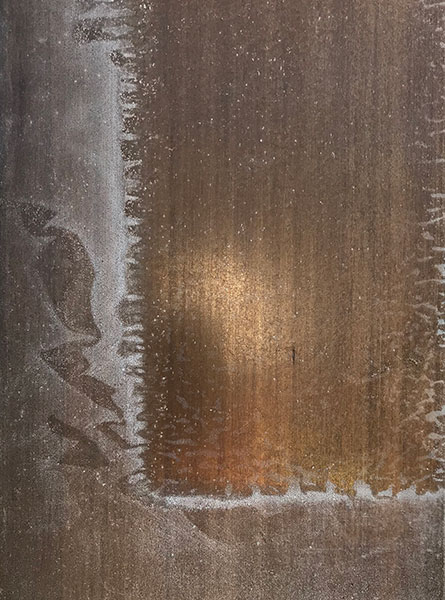
Image: Curtin site inspection, December 2019.

Image: Curtin sculpture seat.
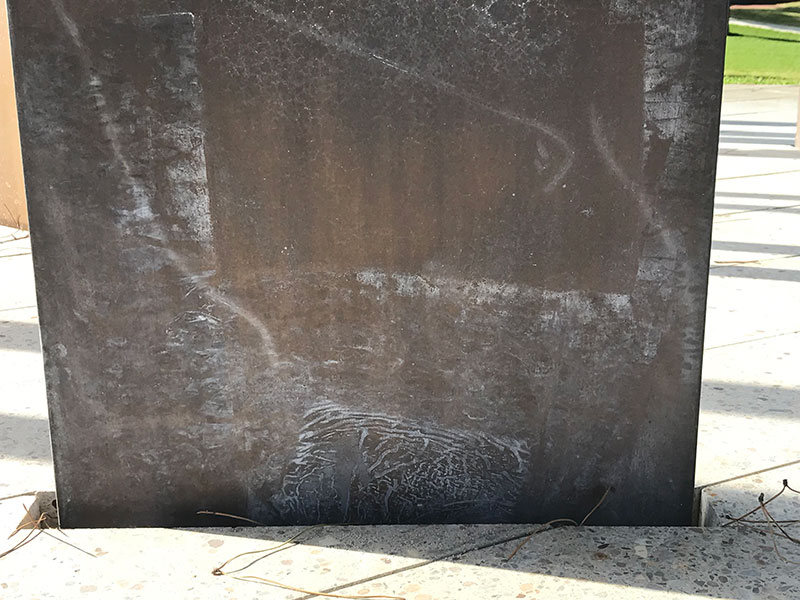
Images: Curtin sculpture installation, February 2020.
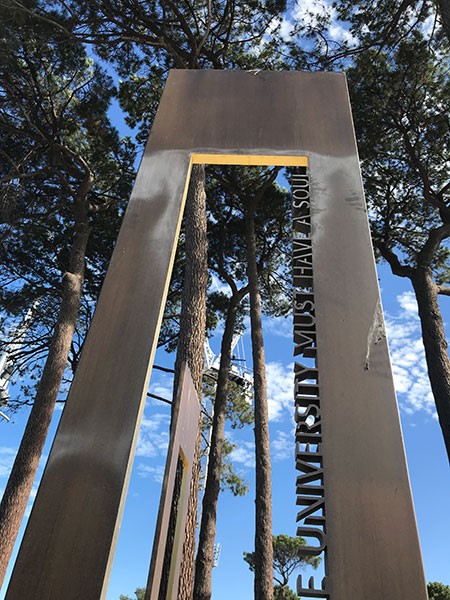
Image: Curtin sculpture after treatment, February 2020.
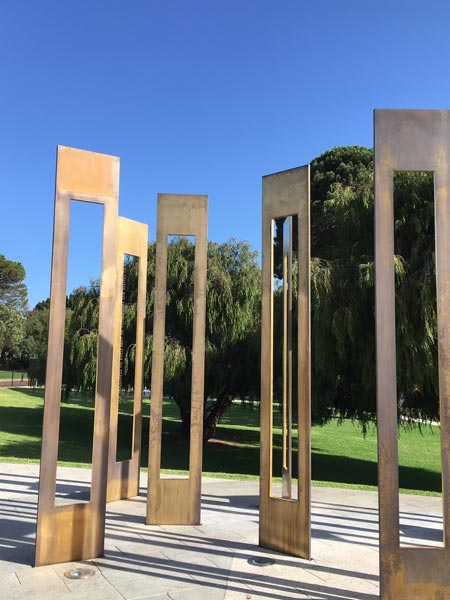
Image: Curtain Sculpture after treatment, February 2020